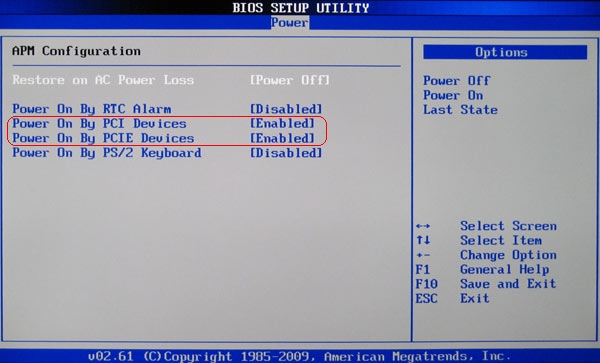

REMOTE WAKE UP BIOS PC
The problem is that this method won’t work for long because once the PC is powered off its entry in the router’s ARP cache (which maps IP addresses to MAC addresses) will expire (not immediately, but eventually) making the PC unreachable. It is possible to get WoL to work across the Internet by giving a target PC a static or reserved DHCP IP address and configuring the router to forward the magic packet to that address. Problem is, few if any consumer/small office routers allow this, as it’s a big no-no for security reasons. Delivering a magic packet to a router is simple enough, but the router must in turn be able to forward the incoming packet as a broadcast to the local network. That’s how WoL works on a LAN, but getting it to function via the Internet isn’t nearly as straightforward. When the target PC– which is still getting power to its network adapter– sees the packet, it recognizes its MAC address within and springs back to life. To reach a PC that’s not running and thus unreachable via TCP/ IP, the packet is broadcast to every system on the subnet.
REMOTE WAKE UP BIOS SOFTWARE
WoL works by creating and issuing a specially formatted network packet (often referred to as a “magic” packet, and typically generated via a software utility) containing a target PC’s MAC address. WoL (which only works on wired connections, incidentally) has been used for years as a way for network administrators to turn on PCs without having to pay them a visit. Setting a system up for Wake-on-LAN (WoL) will allow it to enter various power-saving modes–standby, hibernation, even a complete shutdown–and still let you rouse the system from its slumber when you needed. Keeping a system perpetually powered on can be a tremendous waste of energy and money, and as it turns out you don’t necessarily have to run a system all day and night in order to guarantee remote access. If you regularly access a system from afar, you probably leave it on 24/7 to ensure its constant availability. This may be necessary if you are using a dedicated IP address or another router to connect your computers to the Internet.These days you don’t need to be sitting in front of a PC to use it considering the countless utilities/services that can provide remote access to a system over the Internet. You can send the Magic Packet command to the specified IP (or domain name) and port. The first command to reach your computer wakes it up and the computer appears on the network. to the specified IP address and port (see Router settings).over the local network from neighboring agent programs (if any).Our server sends the Magic Packet command to your computer using all possible methods: In the Permanent Access section, select the computer you want to wake up. Wake-upĪfter activation in BIOS and the network card configuration, go to your personal account. Now your computer is ready for a remote wake-up using the Wake-on-LAN function. Next, go to Power Management and allow the device to wake up the computer using Magic Packet. In the new window, go to the Advanced tab and select the Wake on Magic Packet property. In the "Network adapters" branch, select the one the Ethernet cable is connected to.Ĭlick on the selected adapter.

REMOTE WAKE UP BIOS WINDOWS
To configure the network card, go to the Windows settings and launch the Device Manager. Motherboard manufacturers may have different names for WOL (Agressive Link, ErP, PME). After that, enable Wake-on-LAN in the BIOS menu. To configure Wake-on-LAN in BIOS while booting the device, press a certain key (F1, F2, F11, Escape or Delete depending on the device). Preliminary configuration of a remote computer Activation in BIOS public access to the router and proxying commands to the computer.

presence of other agent programs on the computer subnet.one of the network conditions for receiving the command:.enabled turning on via a local network in the network card settings.The enabled Wake-On-LAN allows the network adapter to constantly scan the network for the Magic Packet command initiating the enabling of a personal computer. Wake-on-LAN (WOL) is a standard protocol for remotely waking up computers that are in low-power mode (turned off but still have access to a power source). Controlled access to your device is not necessary - Wake-on-LAN allows waking up a remote computer without outside help. Wake-on-LAN allows you to remotely turn on the computer by sending a special command via the local network.


 0 kommentar(er)
0 kommentar(er)
